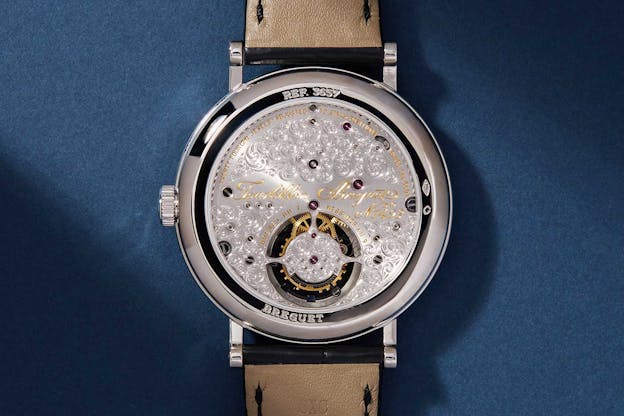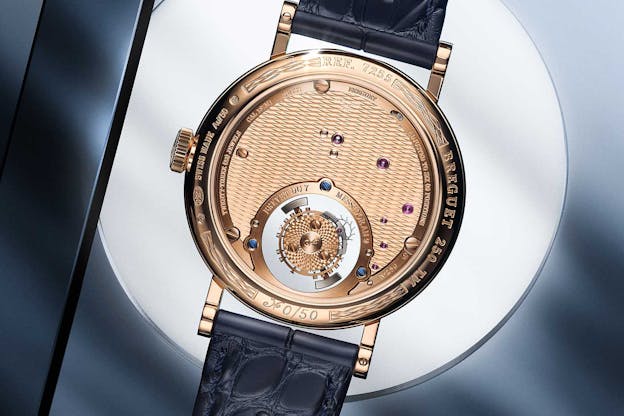Stars And Whirlwinds: In Depth With The Breguet Classique Tourbillon Sidéral 7255
For the 250th anniversary of Breguet, the company’s released it’s first-ever flying tourbillon.
The patent for the tourbillon was granted to Breguet on 7 Messidor, Year IX of the Republican calendar, but thanks to the deeply ingrained human resentment of politically motivated attempts at calendar reform, Tourbillon Day is now celebrated on the Gregorian calendar date of June 26th (and the year the patent was granted was 1801). Breguet did not just invent the tourbillon; he seems to have regarded it as a starting point for a wide range of variations, especially in terms of rotational speeds and escapements, and the length of time required to make any tourbillon (years) and skill necessary to make one (very high) meant that for most of the history of the tourbillon, they were relatively rare, and placed in watches which were intended to be the last word in precision timekeeping.
Today, the tourbillon is produced in a variety, and in numbers, that would have amazed Breguet, with double, multi-axis, and inclined tourbillons being produced by many different makers (and by Breguet, who make the Classique Double Tourbillon) and for the 250th anniversary year, Breguet has produced, for the first time, a flying tourbillon which is also a “mystery” tourbillon – the Tourbillon Sidéral ref. 7255.

The Tourbillon Sidéral is in many respects, a classic Breguet wristwatch, with the fluted coin-edge bezel and welded straight lugs characteristic of the Classique collection. The bezel is relatively narrow and at 38mm x 10.2mm, it’s a classically sized timepiece, running the hand-wound flying mystery tourbillon caliber 187M1.
The basic configuration is one which will be instantly familiar to anyone with even a cursory knowledge of Breguet, and which goes all the way back to the development of the movement developed by Daniel Roth and Lemania for the Breguet 3350, which, when it launched in 1987, was the first tourbillon wristwatch the company had ever produced. Roth would go on to use a variant of the movement, Lemania caliber 387, in his own tourbillon, the C187, in 1989, while it would continue in production at Breguet as the caliber 558. At first the movement was produced by Lemania for Breguet, but in 1992, Lemania was acquired by Breguet and both Breguet and Lemania were acquired by Swatch Group in 1999, and Lemania would become Manufacture Breguet.
The caliber 558 tourbillons typically have a subdial for the time at 12:00, and a very large aperture for the tourbillon below; they are hand-wound movements, running at 2.5Hz/18,000 vph, in contrast to the much more common modern frequencies of 28,800 vph and higher (although many modern tourbillons run at 21,600 vph). Caliber 558 is a 13 3/4 ligne movement, with a 50 hour power reserve, and all those basic characteristics can be found in most cal. 558 tourbillons.
The movement for the Sidéral is the hand wound caliber 187M1; the caliber 187H, which preceded it, is essentially a variation on the 558.


Although the basic layouts are similar, the going train of the 187M1 has been extensively modified in order to support the flying tourbillon, and to reconfigure it as a mystery tourbillon. Mystery clocks and watches are those in which some part of the mechanism appears to move with no apparent physical connection to the mechanism; they were invented, perhaps unsurprisingly, by a 19th century stage magician named Robert-Houdin, and the mechanism was perfected by Maurice Coüet for Cartier, which sold their first mystery clock in 1912. Breguet has made a mystery tourbillon in the past: the Tourbillon Messidor 5335, introduced in 2007, although this is not a flying tourbillon; the upper tourbillon cage pivot runs in a transparent sapphire bridge. A flying tourbillon, on the other hand, has no upper bridge and the cage rotates on only the lower pivot.
Credit is usually given to Alfred Helwig for inventing the flying tourbillon at the Glashütte School of Watchmaking, in 1920, although there is in fact a preceding patent, granted to the English watchmaker Robert Benson North, in 1904. As amazing as it might seem, Breguet has not up to this point, made a flying tourbillon, preferring to concentrate on the classic construction afforded by the caliber 558.
The caliber 187M1 is slightly smaller than a standard 558, at 30mm, although the frequency and power reserve have remained the same: 50 hours, and 2.5Hz/18,000 vph. One big difference between the 187M1 and the 558 caliber is the material: the 187M1 is solid gold – Breguet Gold, in fact, which was introduced this year and which is an alloy of gold, silver, copper, and palladium; palladium is one of the a platinum group metals, which are often added to proprietary rose and red gold alloys in order to prevent discoloring from oxidation of the copper. The movement bridge also has a new guilloché pattern: Quai de l’Horloge, which is a stylized outline of the Île de la Cité, the boat-shaped island in the Seine, at the center of Paris, where the street known as the Quai de l’Horloge is located, and where Breguet had his workshop in Paris.

The rear support for the flying tourbillon is fixed to a sapphire back plate, held in place by three heat-blued screws. This base for the tourbillon cage does not rotate. Instead, the lower pivot of the tourbillon cage rotates inside it. The tourbillon cage itself consists of a sapphire disk, with the upper cage bridge attached to its surface on either side of the balance. The cage is driven on its periphery by hidden gear teeth and as it rotates, the outward facing gear teeth on the fixed base of the tourbillon work against the teeth of the escape wheel pinion (this is more or less how every tourbillon works; the cage rotates around fixed gear teeth, with the escape wheel being driven by the rotation of the cage).

The cage assembly is quite a beautiful little object in and of itself. One of the many interesting features of the tourbillon is the balance spring – it’s a blued Breguet overcoil made of an alloy called Nivachron. Nivachron is an amagnetic titanium based alloy jointly developed by Swatch Group and, rather unexpectedly, Audemars Piguet, and in addition to offering better resistance to magnetism than conventional Nivarox-type alloys, it also offers better resistance to long term magnetism related disturbances in rate (exposure to magnetic fields can compromise the temperature compensation of conventional balance springs). And it looks the part; here it recalls the contrast between the heat blued carbon steel balance springs used by Breguet during his lifetime, and the gilt plates and bridges he used in his watches.

The upper cage bridge is gold, with a steel cap holding the antishock spring, and with a Geneva-style stud holding the outer terminal coil of the balance spring. The quality of the steelwork looks very high, with sharp inner corners and bevels; a lovely piece of work.
The dial is what gives the watch its name.

“Sidéral,” here doesn’t refer to sidereal time, which takes as its basis the sidereal day, in which the length of a day is measured with reference to star transits rather than the passage of the Sun. Instead, it refers to the star-like scintillations of the dial, which is made of aventurine glass enamel.
Aventurine glass was discovered by chance, in Venice, some time in the 17th century and the name is from the Italian “avventura” which means “adventure” or “chance” – supposedly the formula for the glass was discovered by accident. The name aventurine is also given to naturally occurring minerals which resemble the glass, but as far as we know, the glass wasn’t named for the mineral; people starting calling forms of quartzite with internal sparkling inclusions aventurine, for its resemblance to the glass, not the other way around.


The enamel is applied as a powder, which is then fired at high temperature to vitrify it, turning it into a single homogenous layer of translucent, deep blue with gold flakes. You’ll notice that there are several elements of the dial which are elevated above the base layer – the chapter ring for the hours and minutes, the Breguet wordmark and the word “tourbillon,” and the tourbillon itself, all sit proud of the surface. From the side, you can also appreciate the straight lugs, which are hand-welded to the case; the strap’s held in place by screws rather than standard springbars.

The overall effect is quite gorgeous and both as an exercise in technical watchmaking and in watch design, I think it’s a knockout. There is not necessarily any new ground being broken – flying tourbillons have been around for over a century and mystery tourbillons for a couple of decades, in one form or another, but as is so often the case in fine watchmaking, it’s not just what you do, it’s how you do it. The use of Nivachron for the balance spring keeps Breguet in the game when it comes to technical innovation, of course, and the fact that the movement has such a long, rich history is certainly added value (neo-vintage Breguet tourbillons running the caliber 558 were for some time, undervalued for what they offered horologically and historically, although interest in new and vintage Daniel Roth has increased awareness of what they represent; Phillips sold a Breguet 3350 for CHF 78,740 last May in Geneva).
The Sidéral will run you a lot more than that; it’s a 50 piece limited edition and the current price is $226,000. It is, however, setting aside price, an achingly beautiful watch replete with history and with no skimping anywhere in terms of fineness of execution and emotional impact. It will be interesting to see if Breguet has anything really ground breaking technically coming up in the second half of the anniversary year, but in the meantime, for a lot of folks, the Sidéral has set the bar pretty high for any subsequent anniversary releases.
The Breguet Classique Tourbillon Sidéral 7255: case, 18k Breguet Gold, 38mm x 10.2mm with fluted caseband and Quai de l’Horloge guilloché, double AR coated sapphire crystal and sapphire back; 30 meter water resistance. Dial, grand feu aventurine enamel. Movement, hand wound caliber 187M1, one minute tourbillon with small seconds on the tourbillon cage; 13 1/2 lignes/30mm x 4.8mm , running in 23 jewels at 2.5Hz/18,000 vph with 50 hour power reserve; flying mystery tourbillon; plate and bridges in 18k Breguet Gold, with Quai de l’Horloge guilloché. 50 piece limited edition; price, $226,000. The 1916 Company is proud to be an authorized retailer for Montres Breguet; please contact us for any enquiries.

